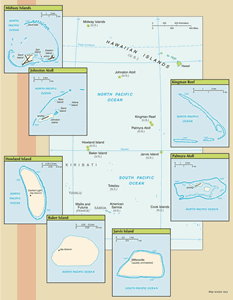The Geography of The United States Pacific Island Wildlife Refuges
The Geography of The United States Pacific Island Wildlife Refuges
Geography
Location: Oceania Baker Island: atoll in the North Pacific Ocean 1,830 nm (3,389 km) southwest of Honolulu, about half way between Hawaii and Australia Howland Island: island in the North Pacific Ocean 1,815 nm (3,361 km) southwest of Honolulu, about half way between Hawaii and Australia Jarvis Island: island in the South Pacific Ocean 1,305 nm (2,417 km) south of Honolulu, about half way between Hawaii and Cook Islands Johnston Atoll: atoll in the North Pacific Ocean 717 nm (1,328 km) southwest of Honolulu, about one-third of the way from Hawaii to the Marshall Islands Kingman Reef: reef in the North Pacific Ocean 930 nm (1,722 km) south of Honolulu, about half way between Hawaii and American Samoa Midway Islands: atoll in the North Pacific Ocean 1,260 nm (2,334 km) northwest of Honolulu near the end of the Hawaiian Archipelago, about one-third of the way from Honolulu to Tokyo Palmyra Atoll: atoll in the North Pacific Ocean 960 nm (1,778 km) south of Honolulu, about half way between Hawaii and American Samoa
Geographic coordinates: Baker Island: 0 13 N, 176 28 W Howland Island: 0 48 N, 176 38 W Jarvis Island: 0 23 S, 160 01 W Johnston Atoll: 16 45 N, 169 31 W Kingman Reef: 6 23 N, 162 25 W Midway Islands: 28 12 N, 177 22 W Palmyra Atoll: 5 53 N, 162 05 W
Map references: Oceania
Area: total - 6,959.41 sq km; emergent land - 22.41 sq km; submerged - 6,937 sq km Baker Island: total - 129.1 sq km; emergent land - 2.1 sq km; submerged - 127 sq km Howland Island: total - 138.6 sq km; emergent land - 2.6 sq km; submerged - 136 sq km Jarvis Island: total - 152 sq km; emergent land - 5 sq km; submerged - 147 sq km Johnston Atoll: total - 276.6 sq km; emergent land - 2.6 sq km; submerged - 274 sq km Kingman Reef: total - 1,958.01 sq km; emergent land - 0.01 sq km; submerged - 1,958 sq km Midway Islands: total - 2,355.2 sq km; emergent land - 6.2 sq km; submerged - 2,349 sq km Palmyra Atoll: total - 1,949.9 sq km; emergent land - 3.9 sq km; submerged - 1,946 sq km
Area - comparative: Baker Island: about two and a half times the size of The Mall in Washington, DC Howland Island: about three times the size of The Mall in Washington, DC Jarvis Island: about eight times the size of The Mall in Washington, DC Johnston Atoll: about four and a half times the size of The Mall in Washington, DC Kingman Reef: a little more than one and a half times the size of The Mall in Washington, DC Midway Islands: about nine times the size of The Mall in Washington, DC Palmyra Atoll: about 20 times the size of The Mall in Washington, DC
Land boundaries: none
Coastline: Baker Island: 4.8 km Howland Island: 6.4 km Jarvis Island: 8 km Johnston Atoll: 34 km Kingman Reef: 3 km Midway Islands: 15 km Palmyra Atoll: 14.5 km
Maritime claims: territorial sea: 12 nm exclusive economic zone: 200 nm
Climate: Baker, Howland, and Jarvis Islands: equatorial; scant rainfall, constant wind, burning sun Johnston Atoll and Kingman Reef: tropical, but generally dry; consistent northeast trade winds with little seasonal temperature variation Midway Islands: subtropical with cool, moist winters (December to February) and warm, dry summers (May to October); moderated by prevailing easterly winds; most of the 1,067 mm (42 in) of annual rainfall occurs during the winter Palmyra Atoll: equatorial, hot; located within the low pressure area of the Intertropical Convergence Zone (ITCZ) where the northeast and southeast trade winds meet, it is extremely wet with between 4,000-5,000 mm (160-200 in) of rainfall each year
Terrain: low and nearly level sandy coral islands with narrow fringing reefs that have developed at the top of submerged volcanic mountains, which in most cases rise steeply from the ocean floor
Elevation extremes: lowest point: Pacific Ocean 0 m highest point: Baker Island, unnamed location - 8 m; Howland Island, unnamed location - 3 m; Jarvis Island, unnamed location - 7 m; Johnston Atoll, Sand Island - 10 m; Kingman Reef, unnamed location - less than 2 m; Midway Islands, unnamed location - 13 m; Palmyra Atoll, unnamed location - 3 m
Natural resources: terrestrial and aquatic wildlife
Land use: arable land: 0% permanent crops: 0% other: 100% (2008)
Irrigated land:
Natural hazards: Baker, Howland, and Jarvis Islands: the narrow fringing reef surrounding the island can be a maritime hazard Kingman Reef: wet or awash most of the time, maximum elevation of less than 2 m makes Kingman Reef a maritime hazard Midway Islands, Johnston, and Palmyra Atolls: NA
Environment - current issues: Baker, Howland, and Jarvis Islands, and Johnston Atoll: no natural fresh water resources Kingman Reef: none Midway Islands and Palmyra Atoll: NA
Environment - international agreements:
Geography - note: Baker, Howland, and Jarvis Islands: scattered vegetation consisting of grasses, prostrate vines, and low growing shrubs; primarily a nesting, roosting, and foraging habitat for seabirds, shorebirds, and marine wildlife; closed to the public Johnston Atoll: Johnston Island and Sand Island are natural islands, which have been expanded by coral dredging; North Island (Akau) and East Island (Hikina) are manmade islands formed from coral dredging; the egg-shaped reef is 34 km in circumference; closed to the public Kingman Reef: barren coral atoll with deep interior lagoon; closed to the public Midway Islands: a coral atoll managed as a national wildlife refuge and open to the public for wildlife-related recreation in the form of wildlife observation and photography Palmyra Atoll: the high rainfall and resulting lush vegetation make the environment of this atoll unique among the US Pacific Island territories; supports a large undisturbed stand of Pisonia beach forest


